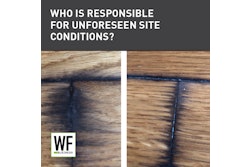
In the June/July 2022 issue of WFB, I detailed the top five clauses a subcontractor should review—and potentially change—before agreeing to a subcontract with a general contractor. Here are more clauses subcontractors should pay close attention to when forming a solid written agreement with a GC:
6. Schedule: Typically a clause is included stating that a sub has reviewed and agrees with the project schedule and understands when the work must be completed (but often no schedule is actually provided).
7. Delays: Subs are usually required to promptly report any delay claims or forever waive them. There is often a very short time period to serve notice of a claim, and if the sub misses the deadline it may not make a claim for more time or increased dollars. If the time frame is short, ask for more time to make such claims. Also ask to strike language stating that the sub’s only remedy for a delay is more time and it waives all claims for additional payment.
8. Termination for Convenience: This clause states that the GC may, at its convenience, terminate the sub for any or no reason. These clauses are common, and most GC’s will not delete them, but make sure this clause states that in such an event, the GC must pay for the labor and materials the sub has contributed to the project through the termination date, including a reasonable profit on that work.
9. Insurance Requirements: The sub will be required to maintain certain types and limits of insurance. Some coverages or duties may require a specific endorsement from the sub’s insurer, and the sub should verify it meets all requirements.
10. Subcontracting/List of Sub Vendors: Confirm whether the GC’s consent is required for the sub to use its own subcontractors. The agreement might also require the sub to provide the GC with a list of all vendors and suppliers and give the GC the right to object to or replace them.
11. Correction of Work/Warranty: Note the time frame to correct work and complete punch lists. These are typically very short and allow the GC to correct the work and back-charge the sub if it misses the deadline.
12. OSHA Compliance/Project Safety/EPA/Lead Paint: This clause will hold the sub responsible for compliance with these rules and require the sub to indemnify, defend and hold the GC harmless from all issues, citations or fines. Pay particular attention to lead paint abatement requirements for any residential properties built prior to 1978.
13. Substance-Free Workplace: The sub’s workers may not use alcohol and controlled substances, which might also include tobacco products, e-cigarettes, and vaping.
14. Citizenship/Authorization to Work: All of the sub’s employees must be legally authorized to work in the USA and the sub will defend and hold GC harmless from all issues, citations or fines.
15. Liquidated Damages: The sub will be liable for a daily penalty if it fails to perform on time. If language states the sub will be liable for liquidated damages contained in the Prime Contract, ask to see the Prime Contract or at a minimum ask if this applies and the dollar amounts of any penalties. Also consider adding language that the sub is only liable for liquidated damages to the extent it was at fault in causing the delays.
16. Leaving Materials and Equipment on Site: Always strike a clause stating that if terminated the Sub must leave all of its materials, tools, and equipment on the job site for use by the GC or a replacement Sub.
17. Proprietary Information/Non-Solicitation: The sub agrees not to solicit GC’s customers or use GC’s information for any purpose outside of the project. Pay attention to whether you do or might do any work directly for the GC’s customer as this clause could prevent that.
18. Independent Contractor Status: The sub agrees that it meets all criteria to be legally deemed an independent contractor and not an employee of the GC.
19. Attorneys’ Fees: Often agreements include a one-way clause allowing the GC recover from the sub all attorneys’ fee incurred in enforcing the agreement. Ask for this clause to be mutual, stating that the prevailing party in any dispute may recover its attorneys’ fees from the other party.
20. Dispute Resolution:
Arbitration vs. Litigation: Note state method of legal action if it is ultimately necessary.
These clauses usually require the sub to continue working while the parties pursue dispute resolution.
Note whether this clause requires the sub to conduct the litigation or arbitration in another state. These clauses are often not enforceable depending on the laws of the state where the project is located. However, if the project is in a state where the laws do not void this type of clause, the sub could be required to travel to another state to resolve disputes. The best practice is to change the state for disputes to the state where the project is located.

































